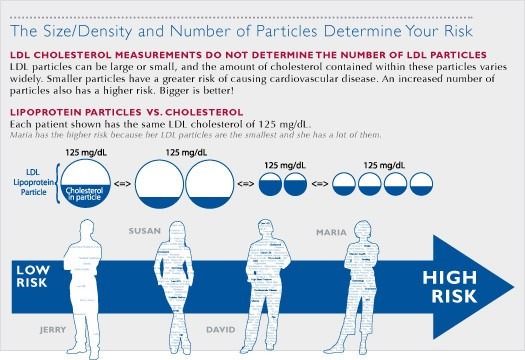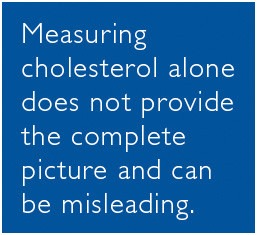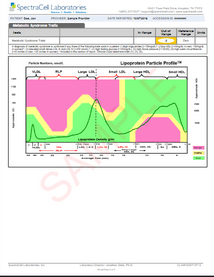Click image to enlarge
Lipoprotein Particle Testing™ (LPP): $250.00
Test includes:
- Lipoprotein Particle Numbers
- Lipoprotein (a)
- Lipid Panel, including Total Cholesterol, HDL Cholesterol, LDL Cholesterol and Triglycerides
**You must fast at least eight (8) hours prior to having your specimen collected
Spectra Cell Laboratories
SpectraCell’s patented, chemically-defined control media contains the minimal amount of each essential micronutrient that is needed to support optimal lymphocyte growth or mitogenic response. The functional intracellular status of micronutrients involved in cell metabolism is evaluated by manipulation of the individual micronutrients in the media followed by mitogenic stimulation and measurement of DNA synthesis.
* NOTE: ALL Lab tests require up to 3 weeks time-frame to be processed and results sent back. Our scheduling system accounts for the 3 week time-frame when scheduling the consultation for your test results review.
Lipoprotein Particle Testing™
Do Cholesterol Numbers Really Assess Cardiovascular Risk?
Lipoprotein Particle Numbers Tell the Story
Overview of lipoprotein particles and cholesterol
Cholesterol testing has historically been used as the standard indicator for cardiovascular disease classified as HDL (good) or LDL (bad). However, it is actually the lipoprotein particles that carry the cholesterol throughout the body, not necessarily the cholesterol within them, that are responsible for key steps in plaque production and the resulting development of cardiovascular disease.
Approximately 50 percent of people suffering from heart attacks have shown “normal” cholesterol numbers (NHLBI – The National Heart, Lung, and Blood Institute).
Now there is an advanced cholesterol testing technology which accurately measures both the density and number of lipoprotein particles. This test is the Lipoprotein Particle Profile™, or LPP™, from SpectraCell Laboratories.
Measuring the lipoprotein subgroups is the only way to evaluate new risk factors, which is crucial for an accurate assessment of cardiovascular risk – according to the National Cholesterol Education Program (NCEP).
NCEP Risk Factors:
- Small, dense LDL: these atherogenic particles are easily oxidized and penetrate the arterial endothelium to form plaque
- Lp(a): this small, dense LDL is involved in thrombosis
- RLP (Remnant Lipoprotein): is very atherogenic, has a similar composition and density of plaque, is believed to be a building block of plaque and does not need to be oxidized like other LDL particle
- HDL2b: positively correlates with heart health because it is an indicator of how well excess lipids are removed
Why is it important to know lipoprotein numbers?
Cardiovascular risk increases with a higher LDL particle count. With a higher non-HDL lipoprotein count the probability of particle penetration of the arterial wall rises, regardless of the total amount of cholesterol contained in each particle. On average, the typical particle contains 50 percent cholesterol.
More than 30 percent of the population has cholesterol-depleted LDL, a condition in which a patient’s cholesterol may be “normal” but their lipoprotein particle number, and hence their actual risk, could be much higher than expected. This is especially common in persons whose triglycerides are high or HDL is low. In the population with a cholesterol-depleted LDL, there can be up to a 40 percent error in risk assessment.
LPP™ Testing is essential to identifying at-risk patients
Up to 50 percent of those who have suffered heart attacks had “normal” cholesterol numbers. How can the large discrepancy between accurate diagnosis and standard cholesterol testing be prevented? Simply by testing the LDL (low density lipoprotein) particle numbers using the Lipoprotein Particle Profile™ (LPP™) from SpectraCell Laboratories.
LPP Plus
- Lipoprotein Fractionation
- Lipoprotein Particle Numbers
- Total Cholesterol
- HDL Cholesterol
- LDL Cholesterol
- Triglycerides
- hs-CRP
- Homocysteine
- Apolipoprotein A-1
- Apolipoprotein B
- Lipoprotein (a)
- Insulin
LPP Basic
- Lipoprotein Fractionation
- Lipoprotein Particle Numbers
- Total Cholesterol
- HDL Cholesterol
- LDL Cholesterol
- Triglycerides
- Lipoprotein (a)
Upon placing and completing your order begins the following steps
You will be emailed your order receipt, in the receipt will be links to a series of forms that will need to be downloaded, filled out and either emailed to me or sent via mail.
Do I fast for the test?
Fasting: 9-12 hours required; except for HgbA1c.
OmegaCheck – preferred but not required. It is recommended that patients do not take a fatty acid supplement within 12-24 hours of collection.
Additional instructions linked here: https://assets.speakcdn.com/assets/2606/specimen-collection-and-processing.pdf
Within a week to 10 days your blood draw, I’ll receive a secure PDF with your results
What results will I see?
SpectraCell’s LPP™ test is a proprietary technology originally developed at Texas A&M University that separates the lipoproteins in blood serum by density using analytical ultracentrifugation, the CDC gold standard for lipoprotein testing, then measures the particles photometrically.
- Lipoprotein Particle Numbers Tell the Story
-
Lipoprotein Particle Testing™
Do Cholesterol Numbers Really Assess Cardiovascular Risk?
Lipoprotein Particle Numbers Tell the StoryOverview of lipoprotein particles and cholesterol
Cholesterol testing has historically been used as the standard indicator for cardiovascular disease classified as HDL (good) or LDL (bad). However, it is actually the lipoprotein particles that carry the cholesterol throughout the body, not necessarily the cholesterol within them, that are responsible for key steps in plaque production and the resulting development of cardiovascular disease.
Approximately 50 percent of people suffering from heart attacks have shown “normal” cholesterol numbers (NHLBI – The National Heart, Lung, and Blood Institute).
Now there is an advanced cholesterol testing technology which accurately measures both the density and number of lipoprotein particles. This test is the Lipoprotein Particle Profile™, or LPP™, from SpectraCell Laboratories.
Measuring the lipoprotein subgroups is the only way to evaluate new risk factors, which is crucial for an accurate assessment of cardiovascular risk – according to the National Cholesterol Education Program (NCEP).
NCEP Risk Factors:
- Small, dense LDL: these atherogenic particles are easily oxidized and penetrate the arterial endothelium to form plaque
- Lp(a): this small, dense LDL is involved in thrombosis
- RLP (Remnant Lipoprotein): is very atherogenic, has a similar composition and density of plaque, is believed to be a building block of plaque and does not need to be oxidized like other LDL particle
- HDL2b: positively correlates with heart health because it is an indicator of how well excess lipids are removed
Why is it important to know lipoprotein numbers?
Cardiovascular risk increases with a higher LDL particle count. With a higher non-HDL lipoprotein count the probability of particle penetration of the arterial wall rises, regardless of the total amount of cholesterol contained in each particle. On average, the typical particle contains 50 percent cholesterol.
More than 30 percent of the population has cholesterol-depleted LDL, a condition in which a patient’s cholesterol may be “normal” but their lipoprotein particle number, and hence their actual risk, could be much higher than expected. This is especially common in persons whose triglycerides are high or HDL is low. In the population with a cholesterol-depleted LDL, there can be up to a 40 percent error in risk assessment.
The most advanced test available to predict heart disease risk, much more so than standard cholesterol testing. It is the number and density (size) of Low Density Lipoprotein cholesterol that provides a better picture of cardiac risk. LPP measures the lipoprotein particles directly giving a more precise evaluation of their size. - LPP Testing Identifies At-Risk Patients
-
LPP™ Testing is essential to identifying at-risk patients
Up to 50 percent of those who have suffered heart attacks had “normal” cholesterol numbers. How can the large discrepancy between accurate diagnosis and standard cholesterol testing be prevented? Simply by testing the LDL (low density lipoprotein) particle numbers using the Lipoprotein Particle Profile™ (LPP™) from SpectraCell Laboratories.
LPP Plus
- Lipoprotein Fractionation
- Lipoprotein Particle Numbers
- Total Cholesterol
- HDL Cholesterol
- LDL Cholesterol
- Triglycerides
- hs-CRP
- Homocysteine
- Apolipoprotein A-1
- Apolipoprotein B
- Lipoprotein (a)
- Insulin
LPP Basic
- Lipoprotein Fractionation
- Lipoprotein Particle Numbers
- Total Cholesterol
- HDL Cholesterol
- LDL Cholesterol
- Triglycerides
- Lipoprotein (a)
- The Testing Process
-
Upon placing and completing your order begins the following steps
You will be emailed your order receipt, in the receipt will be links to a series of forms that will need to be downloaded, filled out and either emailed to me or sent via mail.
Do I fast for the test?
Fasting: 9-12 hours required; except for HgbA1c.
OmegaCheck – preferred but not required. It is recommended that patients do not take a fatty acid supplement within 12-24 hours of collection.
Additional instructions linked here: https://assets.speakcdn.com/assets/2606/specimen-collection-and-processing.pdfWithin a week to 10 days your blood draw, I’ll receive a secure PDF with your results
- Test Examples
-
What results will I see?
SpectraCell’s LPP™ test is a proprietary technology originally developed at Texas A&M University that separates the lipoproteins in blood serum by density using analytical ultracentrifugation, the CDC gold standard for lipoprotein testing, then measures the particles photometrically.



